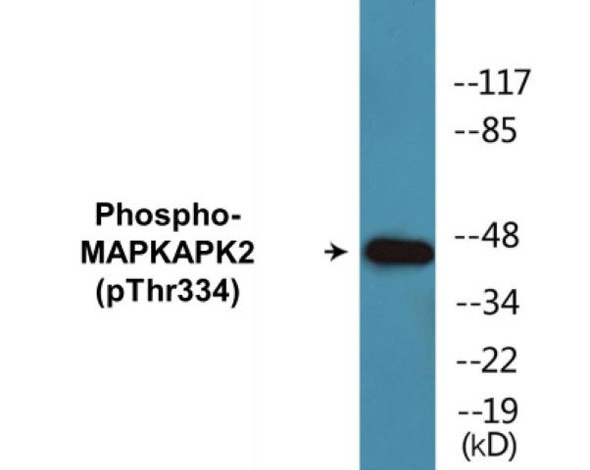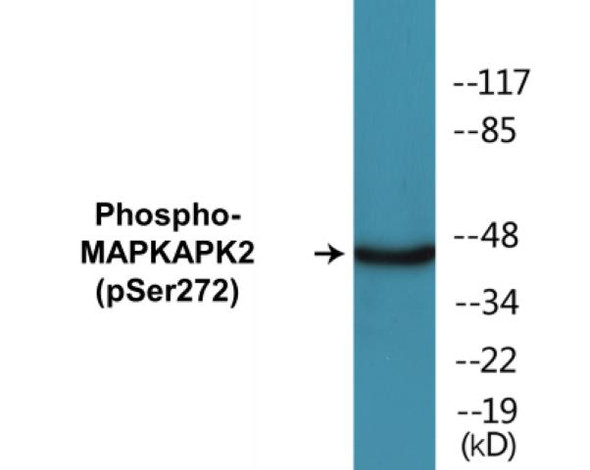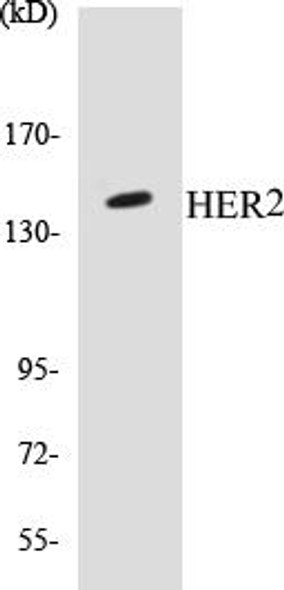Description
MAPKAPK2 Colorimetric Cell-Based ELISA Kit
The MAPKAPK2 Colorimetric Cell-Based ELISA Kit from Assay Genie is a powerful tool for the accurate measurement of MAPKAPK2 levels in cell lysates and tissue samples. This kit boasts high sensitivity and specificity, ensuring precise and reliable results for a variety of research applications.MAPKAPK2, also known as MAP kinase-activated protein kinase 2, is a key player in intracellular signaling pathways, regulating cell growth, differentiation, and survival. Dysregulation of MAPKAPK2 activity is associated with various diseases, including cancer, inflammatory disorders, and metabolic conditions, highlighting its importance as a potential therapeutic target.
With the MAPKAPK2 Colorimetric Cell-Based ELISA Kit, researchers can easily quantify MAPKAPK2 levels in biological samples, enabling further exploration of its role in disease pathogenesis and potential therapeutic interventions. Order your kit today and unlock the potential of MAPKAPK2 research.
| Product Name: | MAPKAPK2 Colorimetric Cell-Based ELISA |
| Product Code: | CBCAB00743 |
| ELISA Type: | Cell-Based |
| Target: | MAPKAPK2 |
| Reactivity: | Human, Mouse, Rat |
| Dynamic Range: | > 5000 Cells |
| Detection Method: | Colorimetric 450 nmStorage/Stability:4°C/6 Months |
| Format: | 96-Well Microplate |
The MAPKAPK2 Colorimetric Cell-Based ELISA Kit is a convenient, lysate-free, high throughput and sensitive assay kit that can detect MAPKAPK2 protein expression profile in cells. The kit can be used for measuring the relative amounts of MAPKAPK2 in cultured cells as well as screening for the effects that various treatments, inhibitors (ie siRNA or chemicals), or activators have on MAPKAPK2.
Qualitative determination of MAPKAPK2 concentration is achieved by an indirect ELISA format. In essence, MAPKAPK2 is captured by MAPKAPK2-specific primary antibodies while the HRP-conjugated secondary antibodies bind the Fc region of the primary antibody. Through this binding, the HRP enzyme conjugated to the secondary antibody can catalyze a colorimetric reaction upon substrate addition. Due to the qualitative nature of the Cell-Based ELISA, multiple normalization methods are needed:
| 1. | A monoclonal antibody specific for human GAPDH is included to serve as an internal positive control in normalizing the target absorbance values. |
| 2. | Following the colorimetric measurement of HRP activity via substrate addition, the Crystal Violet whole-cell staining method may be used to determine cell density. After staining, the results can be analysed by normalizing the absorbance values to cell amounts, by which the plating difference can be adjusted. |
| Database Information: | Gene ID: 9261, UniProt ID: P49137, OMIM: 602006, Unigene: Hs.643566/Hs.713747 |
| Gene Symbol: | MAPKAPK2 |
| Sub Type: | None |
| UniProt Protein Function: | MAPKAPK2: a member of the MAPKAPK family of protein kinases. It is phosphorylated and activated by p38 in response to cytokines, stress and chemotactic factors.MAPKAPK-2 is apparently a direct target of p38 MAPK. HSP27 is one of its in vivo substrates. Two transcript variants encoding two different isoforms have been described. |
| UniProt Protein Details: | Protein type:Protein kinase, Ser/Thr (non-receptor); Kinase, protein; EC 2.7.11.1; Protein kinase, CAMK; CAMK group; MAPKAPK family; MAPKAPK subfamily Chromosomal Location of Human Ortholog: 1q32 Cellular Component: centrosome; cytoplasm; cytosol; nucleoplasm; nucleus Molecular Function:ATP binding; calcium-dependent protein serine/threonine kinase activity; calmodulin binding; calmodulin-dependent protein kinase activity; protein binding; protein kinase activity; protein serine/threonine kinase activity; signal transducer activity Biological Process: activation of MAPK activity; G2/M transition DNA damage checkpoint; inflammatory response; inner ear development; leukotriene metabolic process; MAPKKK cascade; peptidyl-serine phosphorylation; positive regulation of tumor necrosis factor biosynthetic process; protein amino acid autophosphorylation; protein amino acid phosphorylation; Ras protein signal transduction; regulation of interleukin-6 production; regulation of mRNA stability; regulation of tumor necrosis factor production; response to cytokine stimulus; response to DNA damage stimulus; response to lipopolysaccharide; response to stress; toll-like receptor signaling pathway; vascular endothelial growth factor receptor signaling pathway |
| NCBI Summary: | This gene encodes a member of the Ser/Thr protein kinase family. This kinase is regulated through direct phosphorylation by p38 MAP kinase. In conjunction with p38 MAP kinase, this kinase is known to be involved in many cellular processes including stress and inflammatory responses, nuclear export, gene expression regulation and cell proliferation. Heat shock protein HSP27 was shown to be one of the substrates of this kinase in vivo. Two transcript variants encoding two different isoforms have been found for this gene. [provided by RefSeq, Jul 2008] |
| UniProt Code: | P49137 |
| NCBI GenInfo Identifier: | 1346538 |
| NCBI Gene ID: | 9261 |
| NCBI Accession: | P49137.1 |
| UniProt Secondary Accession: | P49137,Q5SY30, Q5SY41, Q8IYD6, |
| UniProt Related Accession: | P49137 |
| Molecular Weight: | 42,203 Da |
| NCBI Full Name: | MAP kinase-activated protein kinase 2 |
| NCBI Synonym Full Names: | mitogen-activated protein kinase-activated protein kinase 2 |
| NCBI Official Symbol: | MAPKAPK2 |
| NCBI Official Synonym Symbols: | MK2; MK-2; MAPKAP-K2 |
| NCBI Protein Information: | MAP kinase-activated protein kinase 2 |
| UniProt Protein Name: | MAP kinase-activated protein kinase 2 |
| UniProt Gene Name: | MAPKAPK2 |
| UniProt Entry Name: | MAPK2_HUMAN |
| Component | Quantity |
| 96-Well Cell Culture Clear-Bottom Microplate | 2 plates |
| 10X TBS | 24 mL |
| Quenching Buffer | 24 mL |
| Blocking Buffer | 50 mL |
| 15X Wash Buffer | 50 mL |
| Primary Antibody Diluent | 12 mL |
| 100x Anti-Phospho Target Antibody | 60 µL |
| 100x Anti-Target Antibody | 60 µL |
| Anti-GAPDH Antibody | 60 µL |
| HRP-Conjugated Anti-Rabbit IgG Antibody | 12 mL |
| HRP-Conjugated Anti-Mouse IgG Antibody | 12 mL |
| SDS Solution | 12 mL |
| Stop Solution | 24 mL |
| Ready-to-Use Substrate | 12 mL |
| Crystal Violet Solution | 12 mL |
| Adhesive Plate Seals | 2 seals |
The following materials and/or equipment are NOT provided in this kit but are necessary to successfully conduct the experiment:
- Microplate reader able to measure absorbance at 450 nm and/or 595 nm for Crystal Violet Cell Staining (Optional)
- Micropipettes with capability of measuring volumes ranging from 1 µL to 1 ml
- 37% formaldehyde (Sigma Cat# F-8775) or formaldehyde from other sources
- Squirt bottle, manifold dispenser, multichannel pipette reservoir or automated microplate washer
- Graph paper or computer software capable of generating or displaying logarithmic functions
- Absorbent papers or vacuum aspirator
- Test tubes or microfuge tubes capable of storing ≥1 ml
- Poly-L-Lysine (Sigma Cat# P4832 for suspension cells)
- Orbital shaker (optional)
- Deionized or sterile water
*Note: Protocols are specific to each batch/lot. For the correct instructions please follow the protocol included in your kit.
| Step | Procedure |
| 1. | Seed 200 µL of 20,000 adherent cells in culture medium in each well of a 96-well plate. The plates included in the kit are sterile and treated for cell culture. For suspension cells and loosely attached cells, coat the plates with 100 µL of 10 µg/ml Poly-L-Lysine (not included) to each well of a 96-well plate for 30 minutes at 37°C prior to adding cells. |
| 2. | Incubate the cells for overnight at 37°C, 5% CO2. |
| 3. | Treat the cells as desired. |
| 4. | Remove the cell culture medium and rinse with 200 µL of 1x TBS, twice. |
| 5. | Fix the cells by incubating with 100 µL of Fixing Solution for 20 minutes at room temperature. The 4% formaldehyde is used for adherent cells and 8% formaldehyde is used for suspension cells and loosely attached cells. |
| 6. | Remove the Fixing Solution and wash the plate 3 times with 200 µL 1x Wash Buffer for five minutes each time with gentle shaking on the orbital shaker. The plate can be stored at 4°C for a week. |
| 7. | Add 100 µL of Quenching Buffer and incubate for 20 minutes at room temperature. |
| 8. | Wash the plate 3 times with 1x Wash Buffer for 5 minutes each time. |
| 9. | Add 200 µL of Blocking Buffer and incubate for 1 hour at room temperature. |
| 10. | Wash 3 times with 200 µL of 1x Wash Buffer for 5 minutes each time. |
| 11. | Add 50 µL of 1x primary antibodies (Anti-MAPKAPK2 Antibody and/or Anti-GAPDH Antibody) to the corresponding wells, cover with Parafilm and incubate for 16 hours (overnight) at 4°C. If the target expression is known to be high, incubate for 2 hours at room temperature. |
| 12. | Wash 3 times with 200 µL of 1x Wash Buffer for 5 minutes each time. |
| 13. | Add 50 µL of 1x secondary antibodies (HRP-Conjugated AntiRabbit IgG Antibody or HRP-Conjugated Anti-Mouse IgG Antibody) to corresponding wells and incubate for 1.5 hours at room temperature. |
| 14. | Wash 3 times with 200 µL of 1x Wash Buffer for 5 minutes each time. |
| 15. | Add 50 µL of Ready-to-Use Substrate to each well and incubate for 30 minutes at room temperature in the dark. |
| 16. | Add 50 µL of Stop Solution to each well and read OD at 450 nm immediately using the microplate reader. |
(Additional Crystal Violet staining may be performed if desired – details of this may be found in the kit technical manual.)






